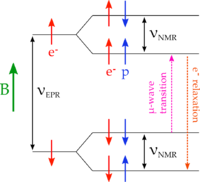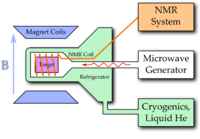Difference between revisions of "Practical Primer on the UVa Target"
(→NMR) |
|||
| Line 1: | Line 1: | ||
| − | This is meant to brief target operators on the general mechanism and systems involved in the UVa target. | + | This is meant to brief target operators on the general mechanism and systems involved in the UVa target. Written by J. Maxwell. |
=Overview= | =Overview= | ||
Revision as of 13:01, 10 September 2011
This is meant to brief target operators on the general mechanism and systems involved in the UVa target. Written by J. Maxwell.
Contents
Overview
Our Dynamically Nuclear Polarized Target can provide greater than 90% proton polarization in an irradiated ammonia target sample, in a 5T magnetic field and at around 1K. The basic operating principle involves leveraging the spin-spin coupling of a free electron in our material to the proton we wish to polarize. In a magnetic field, the spin-spin coupling results in a hyper-fine splitting, as seen in the diagram to the right.
Using microwaves of wavelengths corresponding to the energy gaps, transitions can be induced to flip the spin of the proton along with the spin of the electron. As in the example of the diagram, the (down,down) state can be flipped to the (up,up) aligned state, but by changing the microwave frequency it is also possible to flip the (down,up) state to the (up,down) state, thereby anti-aligning the proton without changing the magnetic field.
Since the relaxation time of the electron at 1K is on the order of milliseconds, compared to proton's tens of minutes, the same electron can be used to polarize many protons. The proton polarization is transferred away from the immediate vicinity of the free electrons via spin diffusion.
Thermal Equilibrium Polarization
The starting point for our technique is quite simple, but still crucial to the operation of the target. By placing our material in a high magnetic field B and at low temperature T, we can expect from Boltzmann statistics that our polarization when the material reaches thermal equilibrium should be:
If we assume a 5T field and 1K temperature, comes out to a proton polarization of around 0.3%. But we notice for electrons, whose magnetic moment is 660 times that of the proton, we have near 100% polarization.
While 0.3% proton polarization is obviously not practical, this starting point will provide a crucial point of calibration as we attempt to measure the polarization with NMR.
Dynamic Nuclear Polarization
To produce high proton polarization, we use the technique of Dynamic Nuclear Polarization (DNP), which we briefly outlined in the overview. There are 5 basic ingredients which go into this technique: a high magnetic field, a low temperature, a microwave system, an NMR system, and a suitable target material. We will briefly walk through these 5 building blocks, and what systems are necessary to provide them in the experimental hall.
Magnetic Field
The magnetic field is provided by a superconducting Helmholtz pair capable of producing 5T at great (10^-4) uniformity in a 3x3x3 cm^3 volume at the target cell. This magnet's open geometry allows for beam to pass at both parallel and perpendicular to the field. An Oxford Instruments power supply provides the necessary current (around 70A at 5T), and controls the modes of operation. During g2p, the magnet will be set at 5T or 2.5T. A reservoir of liquid helium at 4K keeps the magnet superconducting.
The two operating modes are connected and persistant. A superconducting switch, which is simply a length of superconducting wire near a heater coil, changes these modes. In connected, the switch is "opened" by heating the superconducting wire; this "connects" the magnet coils to the leads of the power supply. In persistant mode, the switch is allowed to cool; as the wire again becomes superconducting the relatively high resistance of the power supply leads makes it "invisible" to the current in the superconducting coils.
Magnet energization and de-energization may only be performed by a target expert. The ramp up and down must be carefully controlled to avoid losses in superconductivity called quenches.
Shim Coils The uniform field region can be tuned using a set of shim coils, but in practice this is not necessary. However, leaving the shim coils superconducting while the main coils are being energize will lead to trouble. Unless the shims are held at zero current by their power supply, the current induced from the main coil's energization can result in shim quenches in which too much shim current causes a failure in superconductivity.
Low Temperature
A low temperature is critical to the operation of the target. The temperature's effects are easily seen when observing the polarization over time. As inevitable beam trips occur, the polarization can be seen to rise as the heat load of the beam is removed. When the beam comes back, the polarization drops a few percent simple due to the heat load. An example diagram of the pumps and fridge are shown to the right, although the precise pumps used in the hall are slightly different.
The target, magnet and liquid nitrogen shield are hung in the target can which is held at vacuum by a diff pump. The liquid nitrogen shield, seen in the diagram, protects the liquid helium components from the radiation of the room temperature can.
The refrigerator pulls liquid helium from the magnet reservoir into the separator. The separator can be thought of as a holding reservoir for colder liquid helium before it is transferred to the nose. The nose is bottom of the fridge, where the target material is held. As liquid helium is transferred from the separator to the nose, it passes through heat exchangers which are cooled by evaporating helium being pumped out of the fridge. To maintain the low temperatures in the face of as much as 1W of power coming from the microwaves and beam, huge roots blower pumps work to maintain a low pressure in the refrigerator.
Maintaining the level of liquid helium in the nose is critical to the operation of the target, and monitoring this level is one of a target operator's tasks. Control of the roots blowers is necessary for the annealing of the target material.
Microwaves
The microwaves cause the spin flip transitions and therefore must be tuned very carefully to the frequency of the energy gap to maximize polarization. Unfortunately, as the target material accumulates radiation damage from the beam, this optimal frequency changes. The most important task of the target operators is to constantly monitor and tweak the microwave frequency to maximize polarization.
The microwaves are provided by the EIO tube, which allows the frequency of microwaves to be changed within limits by adjusting a bellows on the oscillation cavity. Wave guides carry the microwaves from the tube to a horn which shine on the target cups.
In g2p, two magnetic field strengths (5T and 2.5T) will be used and thus two nominal microwave frequencies will be used (~140 and 70 GHz). This requires two different EIO tubes, but the operation will be similar.
Target Material
Choosing a target material is a compromise between our desire for a pure proton target, and the practical necessities of materials which perform well under DNP and heavy radiation damage. Ammonia and deuterated ammonia (14NH3 and 14ND3) have emerged as the most attractive materials for our uses. When doped with paramagnetic centers to provide free electrons for the spin-spin coupling, ammonia can achieve greater than 90% proton polarization.
To dope the ammonia with free electrons, it is irradiated in a smaller accelerator before it comes to JLab. This irradiation produces radicals such as NH2 from the NH3 in what is called a warm dose. In the beam at JLab, temperatures are much lower, and different radicals, such as atomic H, are produced under this cold dose.
Anneals
The number of radicals in the material must be carefully balanced to achieve the greatest polarization; although the centers allow us to polarize using our microwaves, they also allow polarization decay short-cuts for the proton. As radiation dose from the beam produces more radicals than needed, the DNP process becomes less efficient and the polarization will drop. However, by heating the ammonia, we can allow some of these radicals to recombine. This heating is called an anneal, and for an experiment that runs at 80nA, it must be performed every day. After an anneal, the polarization will again reach maximal levels.
There is a limit to the lifetime of the ammonia however. As successive anneals are performed on a material sample, the decay rate of the polarization will increase, requiring more anneals per day. This is due to the buildup of radicals which cannot be recombined in an anneal. Eventually, the polarization decay rate will be so fast that it is no longer practical to use the material, so a new ammonia sample will be used. This replacement of material will occur once a week.
NMR
The NMR system is used to measure the proton polarization in the sample.



